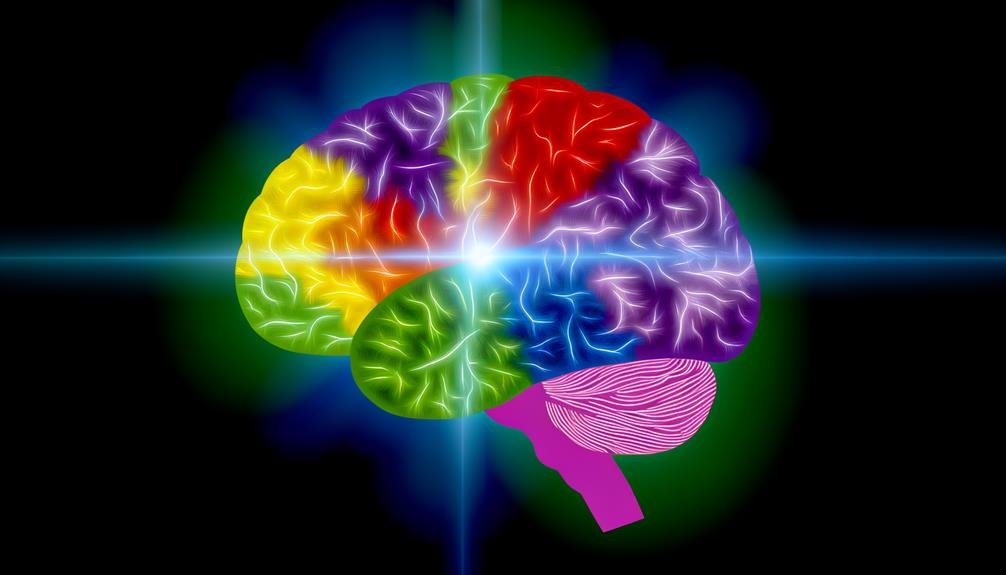Brain's Color Processing: Unlocking Learning Potential
As we navigate the intricate pathways of the brain's color processing, we begin to see how hues act as keys to unlocking hidden doors of learning potential.
The fascinating interplay between colors and cognition hints at a world of undiscovered capabilities waiting to be tapped into.
Join us as we uncover the secrets held within the brain's color perception, shedding light on how this knowledge can revolutionize the way we understand and optimize learning experiences.
Key Takeaways
- Color processing in the brain enhances cognitive functions and memory retention.
- Different colors influence emotions, creativity, relaxation, and focus.
- Margie Meacham integrates neuroscience into practical learning strategies for unlocking genius.
- Understanding brain functions through neuroscience can revolutionize leadership, education, and learning experiences.
Impact of Color on Learning
Color plays a pivotal role in facilitating learning processes by influencing cognitive functions and enhancing memory retention through its intricate processing in distinct regions of the brain. Color perception directly impacts learning enhancement by engaging various cognitive processes. Studies show that color aids in pattern recognition, boosts memory, and influences performance.
Different colors evoke specific emotions, affecting focus, relaxation, happiness, and stress levels. For example, green promotes relaxation and physical health, while red can enhance focus and energy. Understanding the influence of color on the brain can significantly improve learning outcomes. By utilizing the right colors in educational materials, presentations, and environments, individuals can optimize their cognitive functions and memory retention, ultimately unlocking their full learning potential.
Cognitive Benefits of Color Processing
The impact of color on learning extends beyond memory retention, influencing cognitive functions and enhancing overall learning processes through its intricate processing in distinct regions of the brain.
- Color perception: Color information is processed in specialized brain regions and influences various cognitive functions.
- Cognitive enhancements: Colors play a significant role in boosting cognitive processes such as attention, memory, and problem-solving.
- Neural connectivity: Color processing pathways connect with areas responsible for higher-order cognitive functions, enhancing learning outcomes.
- Emotional regulation: Different colors can evoke specific emotions, affecting cognitive performance and overall learning experiences.
Psychological Effects of Color
An individual's psychological responses to different hues can significantly impact their cognitive processes and emotional states. Colors play a crucial role in eliciting emotional responses and influencing attention retention. Different colors can evoke various feelings, affecting how we perceive and interact with our environment. Here is a table showcasing the psychological effects of different colors:
| Color | Emotional Responses | Attention Retention |
|---|---|---|
| Blue | Creativity, relaxation | Improved focus |
| Red | Energy, threat | Enhanced focus |
| Yellow | Happiness, potential stress | Varied attention span |
| Green | Relaxation, health benefits | Sustained attention |
Understanding the psychological impact of color can help optimize learning environments and enhance overall cognitive functioning.
Color's Influence on Memory
Understanding how different colors impact cognitive processes and emotional states can provide valuable insight into how color influences memory retention. When it comes to color association and memory retention, the following points are key:
- Color-Cued Memory: Colors associated with specific objects or concepts can trigger memory recall more effectively.
- Emotional Coloring: Emotional responses to colors can enhance memory formation and retrieval.
- Color Contrast: Utilizing contrasting colors in learning materials can aid in memory differentiation.
- Color Consistency: Maintaining a consistent color scheme throughout learning materials can improve memory retention by providing visual cues.
Margie Meacham's Neuroscience Insights
Exploring Margie Meacham's neuroscience insights reveals groundbreaking connections between brain function and learning potential. Meacham's expertise in neuroscience applications drives learning optimization strategies.
By delving into the intricate workings of the brain, Meacham uncovers practical ways to enhance learning experiences. Her focus on integrating neuroscience theory into learning practices offers a unique perspective on unleashing individual learning potential.
Meacham's contributions emphasize the importance of understanding how the brain processes information to optimize learning outcomes. Through her work, she highlights the transformative impact of applying neuroscience insights to educational practices.
As we navigate the evolving landscape of learning and neuroscience, Meacham's innovative approach paves the way for a future where learning is deeply rooted in the science of the brain.
The Role of Color in Learning
Color perception plays a crucial role in shaping the learning process through its influence on cognitive functions and brain activity.
- Color perception enhances memory retention: Different colors trigger specific responses in the brain, aiding in memory formation and information recall.
- Color-coded information improves learning: Using colors to categorize and organize information can enhance comprehension and retention.
- Color influences emotional responses: Colors like blue promote relaxation, while red enhances focus and energy levels, impacting learning outcomes.
- Color facilitates creativity and problem-solving: Exposure to a variety of colors can stimulate creative thinking and improve problem-solving skills during learning tasks.
Future Learning Trends in Neuroscience
The emerging trends in neuroscience research point towards a future where learning methodologies will be revolutionized through a deeper understanding of brain functions and cognitive processes. Neuroscience innovations are paving the way for enhanced cognitive enhancement techniques that can optimize learning outcomes.
By delving into the intricate mechanisms of the brain, researchers are uncovering novel strategies to enhance memory retention, improve information processing, and boost overall learning potential. These advancements in neuroscience are poised to reshape the landscape of education and leadership development, offering unprecedented opportunities for growth and optimization.
Integrating these cutting-edge neuroscience findings into learning practices holds the key to unlocking the full spectrum of human cognitive capabilities and maximizing individual learning potential in ways previously unimagined.
Conclusion
As we venture deeper into the intricate world of neuroscience and learning, the revelations surrounding the brain's color processing continue to astound us. The potential for unlocking new pathways to enhance learning capabilities through color is on the horizon.
Stay tuned as we unravel the mysteries and uncover the endless possibilities that lie ahead in this fascinating fusion of science and education. The future holds boundless opportunities for maximizing learning potential through the power of color.







